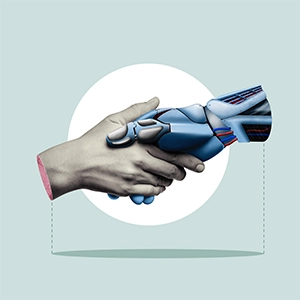AI is rapidly becoming a powerful new toolset, one that could easily revolutionize service information and the way organizations support their customers. In the dynamic landscape of customer service, businesses are constantly seeking innovative ways to elevate their service information experience.
AI creates opportunities to streamline business processes, enhance accessibility and personalize everyday interactions. Through smart use of intelligent automation, organizations can optimize their service operations and improve the customer’s service information experience.
Understanding the Customer Journey
When we say ‘service information experience’ we refer to the journey customers take when the attempt to access information related to their product or service. This journey spans multiple touchpoints, including user manuals and customer support interactions.
A seamless service information experience not only empowers customers to resolve issues independently, but also fosters brand loyalty and satisfaction.
AI is poised to play a powerful role in this journey.
“AI is here to stay,” said Amy Simonelli, Creative Director at Tweddle Group. “From AI voiceover to post-production tools, AI lets us explore process efficiencies and creative approaches to elevating our deliverables in ways previously unattainable.”
"AI lets us explore process efficiencies and creative approaches that weren't really attainable before."
Which brings us to the dreaded question—Should we be concerned? Isn’t AI on track to replace all of us in our jobs?
“As we interact with these tools and learn more about them, we realize they definitely require human supervision,” said Simonelli. “As that happens, I think the aversion to these new technologies will fade. Our team is essential to the success of our AI workflows.”
Leveraging AI for Optimization
AI technologies offer a myriad of capabilities that can significantly enhance the service information experience:
#1 Natural Language Processing (NLP)
NLP enables machines to understand and interpret human language, facilitating more intuitive interactions. Chatbots powered by NLP can engage in conversational exchanges with customers, providing instant answers to queries and guiding them through the troubleshooting process. By emulating human communication, NLP chatbots create a seamless channel for accessing service information.

#2 – Personalization
AI algorithms analyze vast pools of data to identify patterns and preferences, opening up opportunities for a more personalized experience. By leveraging customer data such as purchase history, browsing behavior and previous interactions, businesses can offer highly personalized service information, with solutions tailored to individual needs.
#3 – Predictive Analytics
Predictive analytics algorithms anticipate customer needs and behaviors based on historical data and trends. By proactively addressing potential issues and offering solutions, businesses can enhance the overall service experience.
"By emulating human-like communication, NLP-driven AI chatbots offer an automated frontline of service information and customer support."
For instance, predictive analytics can identify common product issues and provide proactive troubleshooting tips, thereby reducing the need for direct support center contact.
#4 – Visual Recognition
Visual recognition technology enables the identification and analysis of visual content such as images and videos. By incorporating visual search capabilities into service information platforms, customers can simply upload images of product components or error messages to receive assistance. This streamlines the troubleshooting process, particularly for issues that may be difficult to describe verbally.
#5 – Knowledge Management
AI-powered knowledge management systems organize vast repositories of information. This improves access for customers and support agents alike.
These systems employ techniques such as natural language processing and semantic search to retrieve relevant content efficiently. By centralizing and structuring knowledge assets, businesses can ensure consistency and accuracy across all service channels.
Creative Applications of AI for Service Information
One practical example of using AI to create service information is Nissan’s Electronic Quick Reference Guide. The EQRG is a catalog of how-to or “explainer” videos designed to help customers quickly understand their vehicle’s various systems and features.
“We’ve been using AI voiceovers on these videos with great success,” said Simonelli. “The talent is always available when we need them, and adjustments can be made easily when last minute changes are required. We’re currently working on AI voiceover translations in five different languages. The team also employs AI tools to assist with video edits and photo retouching. Many of these tools are available in software we already license. It’s just a matter of digging in and exploring what’s available.”

The opportunities to incorporate AI are constantly evolving. To better understand and leverage the efficiencies this technology can offer, it’s crucial to stay up-to-date on its latest developments.
“I’d like to experiment with using AI backdrops for our photoshoots,” said Simonelli. “Many of our clients don’t have budget for fancy studio sets or location shoots. AI can change all that.”
Looking Ahead: The Future of AI Service Information
As AI continues to evolve, the possibilities for optimizing the service information experience are boundless. Advancements in areas such as natural language understanding, machine learning, and augmented reality promise to further enhance accessibility, personalization, and interactivity. By embracing these innovations, businesses can stay ahead of the curve and deliver service information experiences that empower customers.
“We’re at the tip of the iceberg in terms of AI development,” said Simonelli. “I’m excited to see the technology evolve. I know we’ll continue to find ways for it to enhance our work. I can’t remember a time when the opportunities to enhance our work in truly groundbreaking ways have been so abundant.”

AI represents game-changing technology in the realm of service information experience optimization. By leveraging AI-driven solutions, businesses can streamline processes, enhance accessibility, and personalize interactions, redefining the way customers access and utilize service information.
“We always strive to meet our end users where they are, with the exact piece of information they need in any given moment,” said Simonelli. “AI tools are going to help us deliver a highly customized experience so that consumers no longer have to wade through content that isn’t of value to them.”
No, AI can’t do it all. Part of the challenge of leveraging such powerful technology is finessing the balance between machine automation and human touch.
“The human touch will always be an important part of our deliverables. We always make sure we’re communicating to consumers in natural language. It’s critical that we meet their needs in an effective and appealing way,” said Simonelli. “It’s up to us to make sure AI doesn’t compromise that in any way. It’s not something we can just turn loose and forget about. It’s essential that we monitor what AI is creating and how it’s interacting with our audience.”
As organizations embrace AI-enabled innovation, the service information experience is poised to reach new heights of efficiency and effectiveness.



